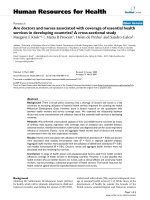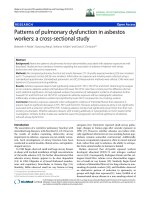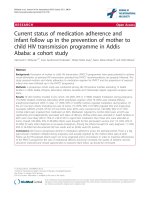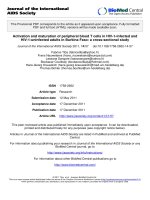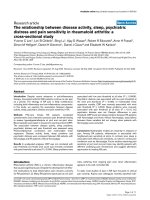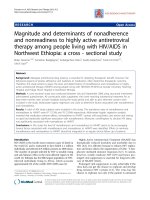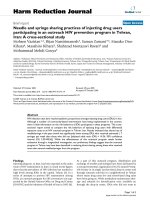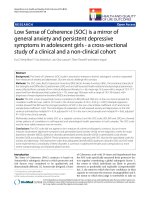PREVALENCE OF CAESAREAN SECTION AND THE ASSOCIATED FACTORS IN PRIVATE HOSPITALS IN ADDIS ABABA a CROSS SECTIONAL STUDY
Bạn đang xem bản rút gọn của tài liệu. Xem và tải ngay bản đầy đủ của tài liệu tại đây (426.18 KB, 58 trang )
ADDIS ABABA UNIVERSITY
COLLEGE OF HEALTH SCIENCES
SCHOOL OF PUBLIC HEALTH
MASTER OF PUBLIC HEALTH RESEARCH THESIS
PREVALENCE OF CAESAREAN SECTION AND THE ASSOCIATED FACTORS IN
PRIVATE HOSPITALS IN ADDIS ABABA - A CROSS-SECTIONAL STUDY
By: Ayodeji Olanipekun (MBBS)
A THESIS SUBMITTED TO THE FACULTY OF PUBLIC HEALTH, SCHOOL OF
GRADUATE STUDIES OF ADDIS ABABA UNIVERSITY IN PARTIAL
FULFILLMENT OF THE REQUIRMENT FOR THE DEGREE OF MASTERS OF
PUBLIC HEALTH IN REPRODUCTIVE HEALTH (MPH/RH)
Advisors: MS. Meselech Assegid (BSC, MPH)
DR. Yirgu G/Hiwot (Department of Obstetrics & Gynaecology)
June 2017
Addis Ababa, Ethiopia
ADDIS ABABA UNIVERSITY
COLLEGE OF HEALTH SCIENCES
SCHOOL OF PUBLIC HEALTH
PREVALENCE OF CAESAREAN SECTION AND THE ASSOCIATED FACTORS IN
PRIVATE HOSPITALS IN ADDIS ABABA - A CROSS-SECTIONAL STUDY
BY AYODEJI OLANIPEKUN
Approval by Board of Examiners
___________________________
Advisor (Name)
_________________________
Internal Examiner (Name)
_________________________
External Examiner (Name)
_______________________
Signature
______________________
Signature
______________________
Signature
Table of contents
Acknowledgement ......................................................................................................................................... I
Acronyms...................................................................................................................................................... II
Summary ....................................................................................................................................................VIII
1. Introduction............................................................................................................................................... 1
1.1 Background ......................................................................................................................................... 1
1.2 Statement of the problem .................................................................................................................... 3
1.3 Significance of the study..................................................................................................................... 4
2.
Literature review................................................................................................................................... 5
2.1 Rising trend in the prevalence of Caesarean delivery ......................................................................... 5
2.2 Non-medical factors............................................................................................................................ 6
2.2.1 Age of the mother ............................................................................................................................ 6
2.2.2 Level of education............................................................................................................................ 6
2.2.3 Socio-economic and insurance status .............................................................................................. 7
2.2.4 Other non-medical determinants...................................................................................................... 8
2.3 Medical factors associated with Caesarean delivery........................................................................... 8
2.4 Conceptual framework......................................................................................................................10
3. Objective .................................................................................................................................................12
3.1 General objective ..............................................................................................................................12
3.2 Specific objectives ............................................................................................................................12
4. Methods ..................................................................................................................................................13
4.1 Study design...................................................................................................................................... 13
4.2 Study area.......................................................................................................................................... 13
4.3 Population ......................................................................................................................................... 13
4.3.1 Source population ......................................................................................................................13
4.3.2 Study population ........................................................................................................................13
4.3.3 Inclusion criteria ........................................................................................................................13
4.3.4 Exclusion criteria .......................................................................................................................13
4.4 Study period ...................................................................................................................................... 13
4.5 Sample size estimation......................................................................................................................14
4.6 Sampling procedure ..........................................................................................................................14
4.7 Data collection procedure .................................................................................................................16
4.8 Data quality control...........................................................................................................................16
4.9 Variables ........................................................................................................................................... 16
4.9.1 Independent variables ....................................................................................................................16
4.9.2 Dependent variables.......................................................................................................................16
4.10 Operational definitions....................................................................................................................17
4.11 Data processing and analysis .......................................................................................................... 17
4.12 Ethical considerations .....................................................................................................................17
4.13 Dissemination of research findings................................................................................................. 18
5. Results.....................................................................................................................................................19
5.1 Sociodemographic characteristics..................................................................................................... 19
5.2 Past obstetrics history .......................................................................................................................21
5.3 Current obstetrics history ..................................................................................................................22
5.4 Bivariate and multivariate analysis .................................................................................................. 26
6. Discussion ...............................................................................................................................................29
7. Conclusion .............................................................................................................................................. 32
8. Recommendations................................................................................................................................... 33
9. References...............................................................................................................................................34
8. Annexes...................................................................................................................................................39
1. Information sheet ................................................................................................................................39
2. Consent form....................................................................................................................................... 40
3. Questionnaire in English.....................................................................................................................41
A Information Sheet, consent form, questionnaire (In Amharic) ...........................................................45
List of tables
Table 1: Socio-demographic characteristics of respondents................................................................... 20
Table 2: Past obstetrics history of respondents .......................................................................................21
Table 3: Current obstetrics history of respondents .................................................................................23
Table 4: Bivariate and multivariate analysis …………………………………………………………………………….……… 27
List of figures
Figure 1: Conceptual framework ............................................................................................................ 11
Figure 2: Schematic presentation of sampling procedure ....................................................................... 15
Figure 3: A pie chart showing the mode of delivery...............................................................................24
Figure 4: A pie chart showing the type of Caesarean delivery ...............................................................25
Figure 5: A bar chart showing the varying indications for Caesarean delivery ...................................... 26
Acknowledgement
I am deeply grateful to my advisors Ms Meselech Assegid and Dr. Yirgu G/Hiwot for their
immense contribution towards this research work.
My sincere gratitude also goes to the Addis Ababa Health Bureau for providing relevant statistics
required for this work and all the private hospital where the data was collected.
To all the parturient who volunteered their time to take part in this study shortly after delivery.
To all my classmates, especially Helen Tesfayohanes and instructors at the School of Public
Health for their support and encouragement during this research.
To Akateh Derek, for being a friend that stuck closer than a brother during our stay in Addis
Ababa and contributing immensely to this thesis.
To my beautiful wife and my lovely daughters (Bridget and Bethel) for staying strong while I
was away from home.
Lastly to God almighty, the giver of wisdom.
Acronyms
AAHB – Addis Ababa Health Bureau
AAU – Addis Ababa University
CD – Caesarean Delivery
CPD – Cephalo-Pelvic Disproportion
FMOH – Federal Ministry of Health
GC - Gregorian Calendar
HMO – Health Management Organization
NGO – Non-Governmental Organization
PH – Private hospitals
VBAC – Vaginal birth after Caesarean section
VD – Vaginal Delivery
USA – United States of America
WHO –World Health Organization
Summary
Background: Caesarean delivery has been increasing at an alarming rate globally. This increase
has become a major challenge across health institutions in both developed and developing
countries. Caesarean delivery rate has been shown to be more common in the private fee–for–
service hospitals than public hospitals. The Ethiopia Demographic and health survey reported an
increase in the caesarean delivery rate between 2005 and 2011 from 16% to 21.8% and even a
higher rate among women who delivered in private health institutions (41.7%) which was twice
higher than their counterparts who delivered in public institutions (20.6%) signifying the
possibility of over-utilization of the service in the private hospital.
Objective: To determine the prevalence of Caesarean delivery and the associated factors in
private hospital in Addis Ababa.
Method: This study was a facility based cross-sectional survey carried out in private hospitals in
Addis Ababa during the months of April to May 2017. Study participants were selected using
multi-stage random sampling technique. Four hundred and eleven consecutive delivered mothers
who consented from the selected private hospitals providing basic and comprehensive obstetrics
services participated in study. A pre-tested structured questionnaire was used to obtain
information from the respondents. Data was entered in Epi Info version 7 and exported to
STATA version 12 for analysis. Multivariable analysis was carried out. Strength of associations
and significance level was examined using odds ratio and 95% confidence intervals respectively.
Result: The prevalence of Caesarean delivery in private hospitals in Addis Ababa was 63.7% [CI
(59.1%, 68.3%)]. Being primiparous [AOR=2.89, 95% CI (1.19, 6.98)], multiparous
[AOR=10.2, 95% CI (4.13, 25.4)], previous Caesarean delivery [AOR=12.48, 95% CI (6.01,
25.95)] and having health insurance coverage were found to be positive and statistically
significantly associated with having Caesarean delivery.
Conclusion: Limiting primary Caesarean delivery to the barest minimum by only performing
such for only absolute indications, allowing vaginal birth after Caesarean section (VBAC)
through close monitoring during labour, counselling of parturient at the antenatal clinics on
possibility of VBAC and the risks associated with unnecessary request for Caesarean section
would be important to decrease the high prevalence of CS.
1. Introduction
1.1 Background
The delivery of the foetus is one of the most highlighted events worldwide irrespective of the route
of delivery; however Caesarean delivery has been increasing at an alarming rate globally. This
increase has become a major challenge across health institutions in both developed and developing
countries. The United States of America (USA) reported a Caesarean delivery rate of 32.2% in 2014,
this represent a steady increase from the rate of 22.8% reported in 1993.[1,2]
Caesarean delivery rate has been shown to be more common in the private fee–for–service hospitals
than public hospitals. The phenomenon is seen in both the developed and developing world.[3,4]
Similarly the Caesarean delivery rates also exceed 20% in most other developed regions of the world
(with the exception of Eastern Europe).[5]
The leading country in terms of the highest Caesarean delivery rate globally is Brazil with a reported
rate of over 50% in 2010, this shows the rising cesarean rate of 1.2% each year from the 30.3%
reported in 1978.[6,7]
In Sub-Saharan Africa, being a low resource setting, the overall reported rate for CD is quite low
between 1-2%, however differential rate has been reported between urban and rural areas with
higher prevalence of CD in urban areas.[3,8]
In Nigeria, Giedam et al evaluating the rising trend and indications of Caesarean section at a
teaching hospital reported a CD rate of 11.8%.[9]
The national review of Caesarean delivery in Ethiopia reported a rate of 15% and 18% for CD in
public hospitals and overall institutional rates respectively.[10,11]
The Ethiopia Demographic and health survey also reported an increase in the caesarean delivery rate
between 2005 and 2011 from 16% to 21.8%. Gebremedhin evaluating the trend and sociodemographic differentials of Caesarean section rate in Addis Ababa, Ethiopia: analysis based on
Ethiopia demographic and health surveys data reported even a higher rate among women who
delivered in private health institutions (41.7%) which was twice higher than their counterparts who
delivered in public institutions (20.6%) signifying the possibility of over-utilization of the service in
the private hospital.[12,13,14] Tsega et al evaluating the prevalence of Cesarean Section in urban health
1
facilities and associated factors in Eastern Ethiopia reported even a much higher prevalence of CS
in private hospitals (58.7%) compared to the 26.6% prevalence in public hospitals.[15]
These figures all exceed the 1985 World Health Organization (WHO) announced maximum
acceptable rate of C-section in each geographical area of 10%-15%.[16]
The International Federation of Obstetricians and gynecologist (FIGO) in their statement about
Caesarean Section states that ‘Some countries have experienced increasing recourse to Caesarean
delivery for non-medical indications. FIGO considers surgical intervention without a medical
rationale to fall outside the bounds of best professional practice. Caesarean delivery should be
undertaken only when indicated to enhance the well-being of mothers and babies and improve
outcomes’ (FIGO 2014).[17]
The factors responsible for Caesarean delivery are very complex and, in addition to clinical
symptoms, it is also dependent on the economic, organizational, and socio-cultural status of
women.[18]
Several factors has been evaluated to be explain this increase in Caesarean delivery rate, these
include medical, non-medical and health service reasons. However the growing consensus presently
is that medical reasons cannot completely explain this increase. There are strong evidences to
suggest that the non-medical factors may be more important in deciding to perform CD in brazil.[19]
Available studies on this topic in Ethiopia has majored on the medical factors responsible for rising
Caesarean delivery rate, there is paucity of data on the non-medical determinants in private hospitals
in Addis Ababa, Ethiopia.
This study assessed both the non-medical and medical factors associated with Caesarean delivery
rate in private hospitals in Addis Ababa.
2
1.2 Statement of the problem
With significant improvement in the choice of anaesthesia, surgical techniques and availability of
blood transfusion services and potent antibiotics Caesarean delivery has become a much safer
procedure, however it is still associated with potential clinical short and long term risk to the mother
and the foetus such as haemorrhage, injuries to abdominal organs, wound infection, uterine
synaechie, secondary infertility etc when compared with spontaneous vaginal delivery. Also,
Caesarean delivery is also associated with increased cost to the health care system and the patient
which is highly important in low resource economic setting. Gonzalez- Perez et al. in a study in
Mexico reported that the extravagant Caesarean delivery is associated with extra cost running into
several millions of dollars yearly and this leads to noticeable impact on the country’s economy.[20] In
the United Kingdom, a newly developed economic model examining the cost of Caesarean delivery
due to non- medical factors showed that annually around 10.9 - 14.8 million additional pounds must
be spent by the health system and the mean saved expenses for each normal vaginal delivery and
appropriate Caesarean delivery was around 1,257 pounds.[21]
In the context of Ethiopia, the World Health Organization (WHO) global study in 2010 estimated the
financial implication of unnecessary Caesarean delivery in Addis-Ababa in terms of hospital
consumables, length of stay in the hospital after surgery, human and time resources and cost of
potential complications from surgery to be 132.7 US dollars per procedure. With a reported 4,076
unnecessary Caesarean delivery conducted in Addis Ababa in 2010 the total cost incurred will be
around 540,885 US Dollars (10,276,815 Ethiopian Birr).[14,22]
It is therefore highly important to determine both the medical and non-medical factors associated
with increasing Caesarean delivery in private hospitals in Ethiopia where the Caesarean delivery rate
is reported to be about 41.7%
[14]
, Ethiopia being a low income country has other more pertinent
health concerns and such resources saved from excessive Caesarean delivery can be invested in
tackling such.
Existing studies on this topic in Ethiopia has focused more on public hospitals and the medical
determinants for CD.
This study determined both the non-medical and medical factors associated with Caesarean delivery
in private hospitals in Addis-Ababa, Ethiopia.
3
1.3 Significance of the study
The higher rate of Caesarean delivery in private hospitals compared to government hospitals is also
associated with huge cost; evidences available are pointing more towards non-medical factors as
being a major factor for this increase.
This study aimed to determine both the medical (CPD, fetal distress, previous CS, malpresentation,
dysfunctional labour etc) and non-medical factors such as maternal age, level of education,
occupation, economic status, health insurance coverage etc which are associated with Caesarean
delivery in private hospitals in Addis-Ababa, Ethiopia.
The result from this study will help to better understand the important factors responsible for
sustaining these trends of increased caesarian section rate in their broader context; it will also help
the government to develop appropriate policies and guidelines for performing and monitoring
cesarean deliveries in the country.
4
2. Literature review
Caesarean delivery refers to the delivery of the foetus through a surgical incision made through the
abdominal wall (laparotomy) and the uterine wall (hysterotomy).
Birth, a normal human physiological process was once a high mortality event causing both serious
maternal and newborn losses. Medical technology and public health measures were introduced to
prevent childbirth complications including cesarean section (CS). CS was at first a major operation
for high-risk pregnancy; there were major operative complications from CS. When surgical and
anesthetic techniques and blood transfusion are well developed, CS safety has been increasing,
leading to a rapid increasing of cesarean section rate.
Several authors have explored the determinants of the rising trend in Caesarean delivery in different
context; however this issue remains a complicated and debatable important health concern. These
determinants has been grouped by authors as medical or clinical, non-medical (socio-economic,
cultural and demographic factors) and institutional/Obstetrician factors. This review of literature
aims to address both the non-medical and medical factors.
2.1 Rising trend in the prevalence of Caesarean delivery
The prevalence of CD has been increasing globally and differential exists between private and public
hospitals. Globally CD rate has been reported to have increased In the United States of America the
CD rate increased from 5.5% in 1970 to 22.8% in 1993 and subsequently to of 32.2% in 2014. [1,2]
In Brazil which is one of the countries with the highest CD worldwide rate of over 50% in 2010,
this shows the rising cesarean rate of 1.2% each year from the 30.3% reported in 1978
[6,7]
, however
there are significant differences between the prevalence of CD among the private and public
hospitals. Viera et al in 2015 reported the prevalence of Caesarean delivery were 29.9 % and 86.2 %
in the public and private sectors in Brazil.[23] Similarly, in another recent study in Mexico, Elena et
al reported that the percentage of CD rose from 45.2% in 2012 to 57.3 % in 2015 with a significant
difference between private hospitals where the percentage CD was at an alarming rate of 85.6 %. [24]
In Ethiopia, there has been a gradual increase in the CD rate with significant differences between the
private and public hospitals. Gebremedhin reported that the CD rate increased significantly from
2.3% in 1995–1996 to 24.4% in 2009–2010. From 2003 onwards, it persisted above 15%. Also he
reported that the rate of CD among parturient who delivered in private health institutions was twice
higher than their counterparts who delivered in public institutions 41.7% vs 20.6%. [14]
5
2.2 Non-medical factors
Non-medical factors that have been studied as being responsible for increasing prevalence of CD
globally include: age of the mother, level of education, socio-economic status, insurance coverage,
maternal demand, religion, employment status, and parity.
2.2.1 Age of the mother
The age of the parturient is one of the non-medical factors that have been considered to be associated
with rising CD globally.
Elena et al in a study on the epidemic of the Cesarean Section in private hospital in Puebla, México
in 2015 reported that the age of the women was directly associated with decision to perform CD. The
frequency of CD was reported to be higher as the mother’s age increased and the vaginal birth
decreased as mother’s age increased, and this was noted to increase significantly in those women
who were older than 30 years old and generally the decision for CD is taken by the mothers without
medical reason. In this study there was significant difference between the ages of women who
attended the private as compared to public hospitals.[24] In Ethiopia, similar findings were reported
showing that the highest percentage of CD occurred between women aged 35-44 years.[14]
Abebe et al evaluating the factors leading to cesarean section delivery at Felegehiwot referral
hospital, Northwest Ethiopia also reported that women in the age category of 15–19 had 37 % lower
probability of CS delivery compared to age category of 20–34 years).[25]
Kahsay et al studying the determinants of CD and its major indications in Adigrat Hospital, Northern
Ethiopia also reported that mothers aged 35 years and above were 3 times more likely to deliver by
CS compared to those aged less than or equal to 24 years old.[26]
This finding has also been corroborated by other authors
[27,28]
, in contrast to this Khawaja et al in
2004 reported that even in the absence of complications among older parturient the rate of CD was
still higher among older parturient, especially primiparous women.[28]
2.2.2 Level of education
The level of education has also been shown to correlate with the choice of delivery; however
findings from different studies have been inconsistent. In Mexico, higher level of education was
associated with increased choice for CD; more than 56.7 % of the mothers with graduate education
had CD in the private facility as compared to 18% in public hospitals, also the prevalence of CD
decreased consistently with decrease in the level of education.[24] In China educated women were 3-4
6
times more likely to have a cesarean section as compared to illiterates.[29] These findings are also
consistent with findings in Ethiopia where higher level of education was associated with increased
prevalence of CD (higher education-33.3%, secondary education-32.3%, primary education-15.8%,
illiterates-14.8%).[14] This was also consistent with the findings from a study by Bayou et al
evaluating pattern of CD in Addis Ababa which reported highest CD rate among women who had
tertiary (33.6%) and secondary education (22.2%).[30]
In contrast some studies in India and Brazil [31,32] showed no association between level of education
and prevalence of CD.[31]
2.2.3 Socio-economic and insurance status
Several studies have found socio-economic status and insurance status to be significantly associated
with CD.[14,24,30,31,33]
The findings reported in a Mexican study [24] showed that parturient with a stable socioeconomic
status opted to deliver in the private hospitals in order to evade all the administrative procedure in
the public hospital that is also associated with a poor medical attention due to the quantity of women
that each doctor has to attend daily. The highest rate of cesarean section found in the private
hospitals could be explained by the economic incentives to doctors, which are usually three times
larger than those obtained with a vaginal birth, in a cesarean procedure in México a doctor could
earn between $1000-2900 USD in the private sector. However, economic incentives do not explain
what happens in the public hospitals where doctors do not receive extra payment for performing a
cesarean section. In the context of Ethiopia
[14]
, CD rate were increased across all the level of
household wealth index (Rich, Middle-income, poor), however the highest prevalence of CD was
found among the rich (28.6% vs 19.5% vs 16.4%;[34] hence the socio-economically empowered
women who have limited financial barriers may over-utilize the service. In contrast employment
status did not alter the prevalence of CD as the CD rate among the unemployed and the employed
were almost the same (21.7% vs 21.2%).
The type and level of insurance coverage for parturient is another important non-medical
determinant for increasing CD which has been studied.[35-39] Studies in the US has shown higher
prevalence of CD among parturient under private insurance coverage (high financial support) than
those receiving Health Maintenance Organization (HMO) support.[35-37] Similarly, Ostovar et al
[39]
reported than in Iran with a 74.6% total insurance coverage in the population under study . In this
7
study, complementary insurance coverage was also offered to the parturient, this covered 40.4% and
8.8% of women with CS and NVD, respectively. The result showed higher prevalence of CD
compared to NVD among those who were covered with insurance (52.8% vs 47.2%), more
significantly the CD rate was much more increased among those who received complimentary
insurance compared to those who did not (81.5% vs 18.5%).
One of the reasons adduced for this significant increase may be the fear of legal or penal problems
and the lack of clear and adequate laws and regulations to support specialists as well as the lack of
necessary standards and sufficient insurance coverage and support regarding medical procedures. A
recent study in Ethiopia also agree with above findings showing that the prevalence of CD was
higher among women in high socio-economic class (27.6%), high-wealth quintile (20.2%) and
women who had health insurance coverage (30.4%)[30], however it is important to note that this
study analysed data from information provided by mothers from their last pregnancies and
childbirth.
2.2.4 Other non-medical determinants
The other non-medical determinant that has been discussed in literature as contributing to increasing
rate of CD globally include the parity of the parturient, marital status, avoidance of pain by the
patient during NVD and provider convenience.[14,25,26,40,41]
Higher CD has been reported among Nulliparous women and the prevalence decreases with higher
parity.[14,25,26] However the incidence of cephalo-pelvic disproportion (medical indication for CD) is
commoner in nulliparous women.
2.3 Medical factors associated with Caesarean delivery
The leading medical indications for Caesarean delivery in several studies were; non-reassuring fetal
status or fetal distress, failure to progress in labour or arrest of dilatation, previous Caesarean
delivery,
malpresentation
and
hypertensive
disorders
in
pregnancy (pre-eclampsia
and
eclampsia).[42,43,44]
In developed countries, the rising trend in Caesarean delivery rates was more related to previous
Caesarean delivery than any other clinical factors,[43] however this is quite different for developing
countries, where the leading medical indication for Caesarean delivery is fetal distress and
dystocia.[45,46] Consequently, there is a trend of performing more elective Caesarean deliveries in
developed countries than in developing countries where majority of Caesarean sections are
8
performed as emergency procedures.[47] Barber et al in a study in the United States of America
examining the indications for Caesarean section to describe factors contributing to increases in
Caesarean delivery rate found that primary Caesarean sections contributed to 50% of the increase in
Caesarean section rate, the rest being repeat Caesarean sections. Considering the primary Caesarean
sections, more subjective indications like non-reassuring fetal heart rate status contributed more to
the rates than the more objective indications like malpresentation, cord prolapse and abruptio
placenta.[42] The study concluded that modifiable factors were involved and that it is possible to
reduce Caesarean section rates.
Other clinical factors like multiple pregnancy, macrosomia, ante-partum haemorrhage, and failed
induction contributed less significantly to the rise in Caesarean section rates. [42]
In a recent systematic review to examine the rising trend in Caesarean section worldwide, Elena et al
[48]
showed that the most frequently reported CS indications were; cephalo-pelvic disproportion
(CPD), fetal distress, prior cesarean, dysfunctional labor and elective cesarean. Among these
indications, the majority of them were maternal indications and only one represents a fetal
indication. However the indications were different among countries and the health sector analyzed,
for example Chanrachakul et al.
[49]
showed that in Thailand a previous Caesarean was the most
prevalent indication in private hospitals (63%), followed by failure to progress (22%) in the public
sector. Otherwise a study in México, established that the main indication in both sectors were
previous CD with a prevalence of 40.8% in private hospitals and 38.5% in public hospitals. Fetal
distress was the prior indication in the private sector (9.5%) and (9%) in a public one; the second
most frequent cause was CPD with 5.8% and 3.9% respectively.[50] In Taiwan the following were
the common indications: malpresentation (28.1%), prior cesarean delivery (28.1%), dysfunctional
labor (26.4%) and fetal distress (8.3%).[51] In a multi-country study on Caesarean Section rates and
indications in Sub-Saharan Africa, the most common indication was obstructed labour (31%).Other
indications included poor presentation (18%), previous Cesarean section (14%), fetal distress (10%),
uterine rupture (9%) and antepartum hemorrhage (8%).[8]
It was established in Ethiopia that CPD (34%) was the main indication, followed by fetal distress
(15%) and with (14%) breech/multiple gestations or abnormal presentation.[10]
Ayano et al also showed that the leading indications for CD were, cephalo-pelvic disproportion
(38.1%), previous CD (18.9%), fetal distress (12.5%), mal-presentation and malposition (7.1%), and
9
antepartum haemorrhage (6%).[52] This finding were consistent with similar studies in
Ethiopia.[25,26,53]
2.4 Conceptual framework
Several factors have been shown to lead to increasing rate of Caesarean delivery. These factors have
been classified as non-medical, medical/clinical and institutional/Obstetrician factors.
Non-medical factors include age, parity, level of education, wealth status, employment status, health
insurance and marital status. These factors usually lead to increase in demand side and subsequently
to increase in Caesarean delivery.
Medical/clinical factors involves a wide range of maternal or foetal clinical indications for
Caesarean delivery such as previous Caesarean delivery, cephalo-pelvic disproportion, labour
dystocia, malpresentation, fetal heart rate irregularity, multiple gestation and suspected foetal
macrosomia just to mention a few.[43]
Institutional/Obstetrician factors include: economic incentives where CD are performed for financial
gains, time management where the Obstetrician perform CD due to lack of time to monitor the
patient to achieve vaginal delivery and also risk minimizing behaviour in order to avoid medicolegal actions when a catastrophic event occurs. These factors lead to medicalization of CD.[54]
Despite the proven safety of Caesarean delivery, there are grave consequences that could follow the
increasing CD especially to the mother and the institutions/Obstetrician. These include physical and
psychological cost on mother also economic cost on the patient and health institution.
10
SOCIO-ECONOMIC AND
DEMOGRAPHIC FACTORS
Age
Parity
Education
Wealth status
Employment status
Health insurance status
Marital status
DEMAND SIDE
FACTOR
CAESAREAN
DELIVERY
INSTITUTIONAL /OBSTETRICIAN
FACTORS
Economic incentives
Time management
Risk minimizing behaviour
MEDICALIZATION
MEDICAL FACTORS
CPD
Fetal distress
Previous CD
Dysfunctional labour
Malpresentation and
malposition
Others
CLINICAL REASON
Adapted from Ghosh 2012 with modification after review of literatures [54]
Figure 1: Conceptual framework
11
3. Objective
3.1 General objective
To assess the prevalence of Caesarean delivery and its associated factors in private hospitals in
Addis Ababa, Ethiopia, 2017
3.2 Specific objectives
To determine the prevalence of Caesarean delivery in private hospitals in Addis Ababa,
Ethiopia.
To assess the factors associated with Caesarean delivery in private hospitals in Addis Ababa,
Ethiopia.
12

